From scheduling to file sharing, the right app can help you work smarter and communicate better with your virtual assistant.
Virtual assistants offer remote administrative, creative, or technical support to businesses and individuals. However, coordinating from different locations has its challenges, including miscommunication, scheduling conflicts, and complex task management.
Virtual assistant apps help streamline communication, manage tasks, track projects, and keep everything organized.
In this article, I reviewed the 5 best apps for virtual assistants, including:
Our Top Picks
-
1
Best all-in-one app for virtual assistants
-
2
Good for task and project management
-
3
Good for real-time communication and team collaboration
Why trust us?
Our team of unbiased software reviewers follows strict editorial guidelines, and our methodology is clear and open to everyone.
See our complete methodology
What to Look For in a Virtual Assistant Apps
Here’s what I looked for to find the best apps for virtual assistants:
Must-have features
- Task management: The app must let managers create, assign, prioritize, categorize, and track progress of all tasks.
- Real-time scheduling: You should be able to manage appointments, set deadlines, and coordinate meetings.
- In-app communication: The software should support team collaboration through updates, chat, and instant messaging.
- File and document management: Team members must be able to upload, organize, and share files and documents across the app.
- Time tracking: You should be able to monitor how long tasks take, log billable hours, and track productivity.
- Notifications and alerts: The app should offer customizable, automatic notifications to update virtual assistants about task changes, upcoming deadlines, or new messages.
I also made sure the software is:
- User-friendly, so virtual assistants can get up to speed right away.
- Affordable, to work with budgets of all sizes.
- Mobile-accessible, so virtual assistants and managers can access assets from anywhere.
Finally, I checked for features that make virtual assistant software shine:
- Integrations to sync with the tools you’re already using in your day-to-day workflows.
- AI-powered automations to speed up repetitive processes for your virtual assistant.
The 5 Best Virtual Assistant Appss of 2025
-
Connecteam — Best all-in-one app for virtual assistants
Connecteam is an all-in-one virtual assistant app. It helps managers and virtual assistants work together successfully by combining task management, scheduling, time tracking, and communication tools in one easy-to-use platform.
Why I chose Connecteam: Connecteam stood out to me for its mobile-first design and range of unified features. I was impressed that you can really manage all your work from one place, without having to switch apps.
Let’s take a deeper look at what Connecteam has to offer:
Manage all your tasks
Connecteam makes employee task tracking simple and seamless. I liked that I could easily assign tasks with detailed instructions, deadlines, and file attachments, and break larger projects into subtasks. What’s great is that Connecteam automatically tracks each task’s status, so you instantly see your virtual assistant’s progress at a glance.
I appreciated being able to set recurring tasks, instead of having to create new tasks every time for routine work. It was easy to assign tasks to individuals or groups, and everyone gets notified right away so responsibilities are clear. Plus, each task has a built-in chat, so you can collaborate in real-time and keep the conversation focused on the specific task.
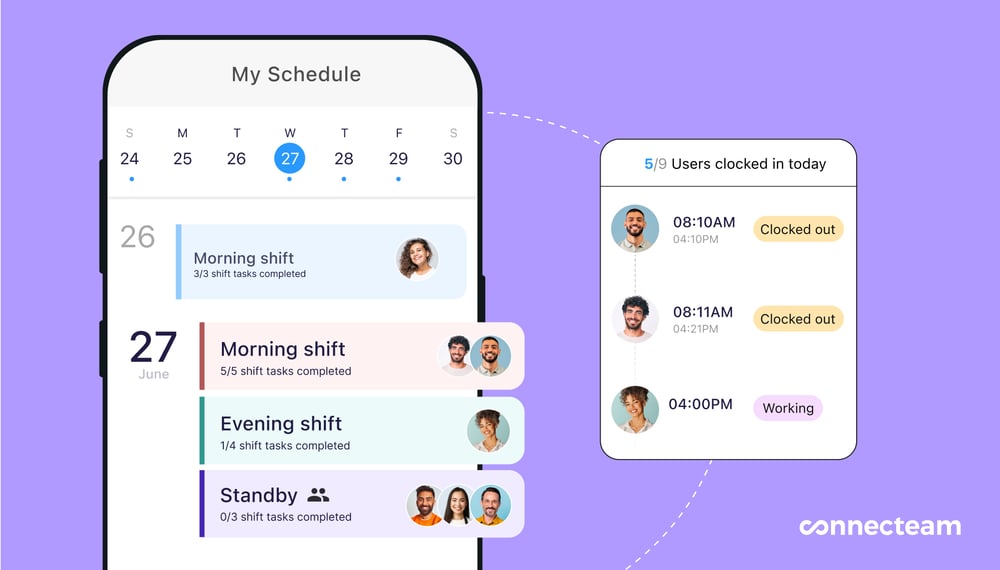
Smarter scheduling
What impressed me about Connecteam’s employee scheduler was how fast it made the process. Instead of the usual back-and-forth, Connecteam made scheduling straightforward with its drag-and-drop editor and clean interface. You can also add notes and attach tasks directly to the schedule, so nothing gets missed. Virtual assistants can view schedules, request changes, and mark their availability and work preferences right from the app.
You can set up recurring schedules for routine tasks, so you don’t have to build one from scratch every week. If you have multiple virtual assistants, there’s the AI-powered auto-scheduler, which instantly assigns open shifts based on employee availability, role, and qualifications.
Connecteam also sends automatic reminders and notifications, making it easier to stay on top of deadlines, meetings, and updates. This makes it so much less stressful to coordinate across multiple time zones.
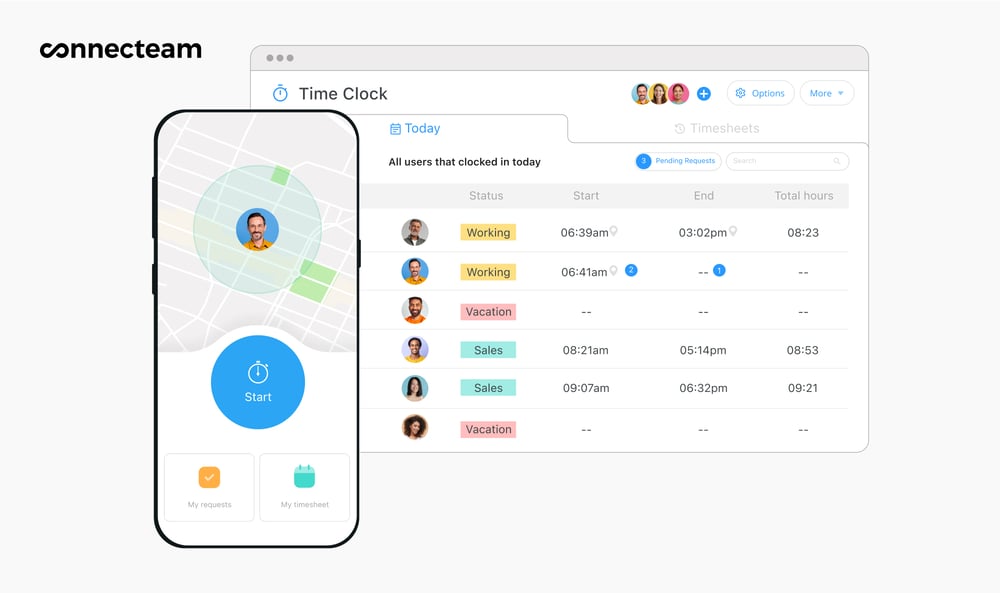
Track time accurately
Connecteam’s employee time clock is great for tracking how long your virtual assistant spends on certain tasks. The time clock supports both automatic and manual entry, and you can track time against specific tasks. I also liked the reporting functionalities, which can pull summaries of hours worked, overtime, or productivity trends.
Virtual assistants can clock in and out from the app, and all their hours are automatically logged into timesheets for payroll. You can edit, review, and approve entries and then export them directly into your payroll provider. It’s a huge lifesaver when it comes to admin work and ensures that your virtual assistants are paid properly and promptly.
Speaking of integrations…
Connecteam offers an API integration and connects with tools you already use, including:
…And so much more
Connecteam has so many tools that make working with virtual assistants easier. The online team chat keeps communication in one place, so you don’t have to switch apps just to send a quick message. There’s built-in onboarding so your team can learn how to use Connecteam fast, and you can even create your own training from scratch or instantly with the AI course creator. Store, organize, and share important information in the company knowledge base, which virtual assistants can find in seconds by asking Connecteam’s AI agent. Connecteam offers all this, and so much more to help you manage your virtual assistants.
Key Features
- Task management
- Built-in chat
- Custom reports and forms
- Automated scheduling
- Digital timesheets
- Time clock
Pros
- All-in-one platform
- Intuitive and easy to use
- Budget-friendly
- AI Agent
Cons
- Needs internet or Wi-Fi access to work
Pricing
Free-for-life plan availablePremium plans start at $29/month for 30 users
14-day free trial, no credit card required
Start your free trial -
Asana — Good for task and project management

Asana is a project management platform that helps teams and virtual assistants manage workflows, track progress, and collaborate on tasks.
Why I chose Asana: I liked Asana because of its strong project organization tools, which make it a good option for virtual assistant work.

Managing tasks and projects
I really liked Asana’s task management features. You can create, assign, and prioritize tasks, which helps keep projects organized. I found it pretty easy to add due dates, dependencies, and custom fields to each task. I also appreciated the different project views, including lists, boards, Gantt charts, and calendars, which let you visualize tasks in whatever way works best for you.
I found the drag-and-drop setup straightforward to use, and it lets you move tasks to different categories, like “Do today” or “Do tomorrow.” It was nice being able to break complex projects into sub-tasks. There’s also a feature that lets you turn emails into tasks by essentially forwarding emails to Asana.
Workflows and integrations
Asana’s automation capabilities impressed me. You can create custom rules that trigger specific actions, like moving tasks from one phase to another or assigning follow-ups to team members. Integrations are also pretty strong, connecting to tools like Slack, Google Calendar, and Jira for more connected workflows.
However, I found it frustrating that project statuses aren’t updated automatically based on task progress. That means that you either have to create a custom rule or manually update the statuses, which seemed a bit unnecessary to me.
Time tracking and limitations
When it comes to time tracking, Asana has a lot of room for improvement. The in-app time tracking is extremely basic, so virtual assistants would probably need to rely on a third-party tool to log their billable hours. There’s no easy way to track hours within tasks, which could make it difficult to run reports. To me, time tracking felt more like an afterthought, rather than a core feature.
I was also disappointed by Asana’s pricing, which is generally more expensive than most of the other virtual assistant apps I looked at. While there is a free plan, it’s pretty limited, which means that you would need a paid plan in order to get the most use out of the tool. Paid plans start at $10.99 per user per month, which can add up quickly, even if it’s just two or three users per plan.
What users say about Asana
Asana offers excellent features for planning and managing tasks during projects. I like the user interface which is simple and makes it easy for me to access and work with all the features.
While the mobile app is functional, it’s not as fluid or feature rich as the desktop version. Some users find task editing and navigation a bit clunky on smaller screens.
Key Features
- Task and project management
- Multiple project views
- Workflow automations
- Email-to-task creation
Pros
- Many integrations
- Customizable and flexible
Cons
- Limited time tracking
- Expensive paid plans
Pricing
Starts at $10.99/user/month Trial: No Free Plan: Yes — Up to 15 people
-
Slack — Good for real-time communication and team collaboration
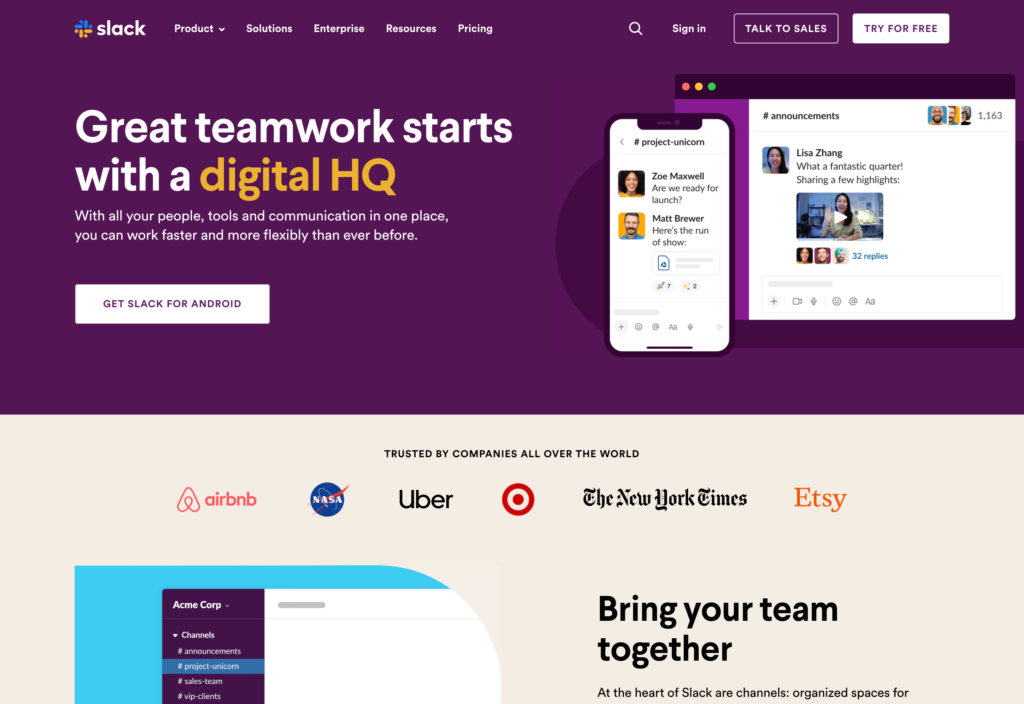
Slack is a communication and collaboration platform that offers a range of ways to connect, including channels, direct messaging, video and voice calls.
Why I chose Slack: I liked that Slack offers so many different ways for teams to collaborate, and I was interested in learning more about its potential for virtual assistants.
Team collaboration
Slack shines when it comes to communication. I liked that you can organize conversations by team, client, or project with channels. You can also open public channels or private ones, depending on what your work calls for. Each channel has its own history, files, and members, so you can really focus on the topic at hand.
In addition to channels, you can send one-on-one or smaller group chats, plus there are “huddles,” which let you hop on quick audio or video calls to clarify something in the moment. The interface felt very clean, and I liked that you can have threaded chats within channels to keep the general conversation organized. There’s a search to help you find what you need, and you can tag people when you need their attention.
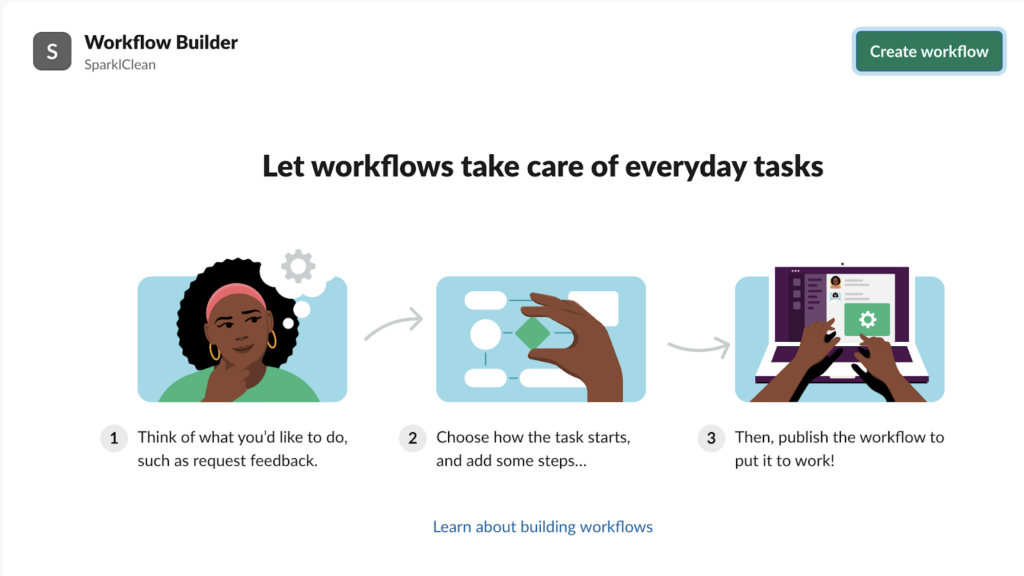
Integrated tools
Another area that really impressed me about Slack was its extensive list of integrations. Slack connects to over 2,000 third-party apps, making it a helpful hub, if you have the time to set it up. I liked being able to link so many different tools, like Google Drive for file access, Asana or Trello for task management, and Hubspot or Mailchimp for marketing.
Slack has a workflow builder that helps automate repetitive tasks. You can set up reminders, schedule messages, or connect to payment platforms like Stripe and PayPal for payment notifications. I can see these integrations being great if you already use these tools in your day-to-day, but I was also a bit overwhelmed at how complex the system management seemed.
Where it falls short
Slack doesn’t quite stack up as a full-service virtual assistant app. I was disappointed at the lack of native tools, like task management, scheduling, and time tracking. Instead, I felt like there was an overreliance on external tools, which are just additional costs, logins, and setups you and your virtual assistant need to sort through.
I also thought that the free plan was pretty limited, since messages and files disappear after 90 days, unless you upgrade to a paid plan. If you do upgrade, plans start at $8.25 per user per month, which doesn’t include how much you would need to spend on other apps to supplement Slack. Plus, Slack’s mobile app doesn’t let you manage automations or integrations, making it less useful for virtual assistants who need to access everything on the go.
What users say about Slack
Slack is very easy to use. We like that you can include just certain people in a chat and not the whole company when needed.
Sometimes Slack feels distracting with too many notifications. Also, older messages get harder to find after a while.
Key Features
- Direct messaging
- Channels
- Audio and video calls
- Automated workflows
Pros
- Strong integrations
- Intuitive interface
Cons
- Limited reporting features
- Restrictive free plan
Pricing
Starts at $8.25/user/month Trial: Yes Free Plan: Yes
-

Apploye — Good for time and activity tracking
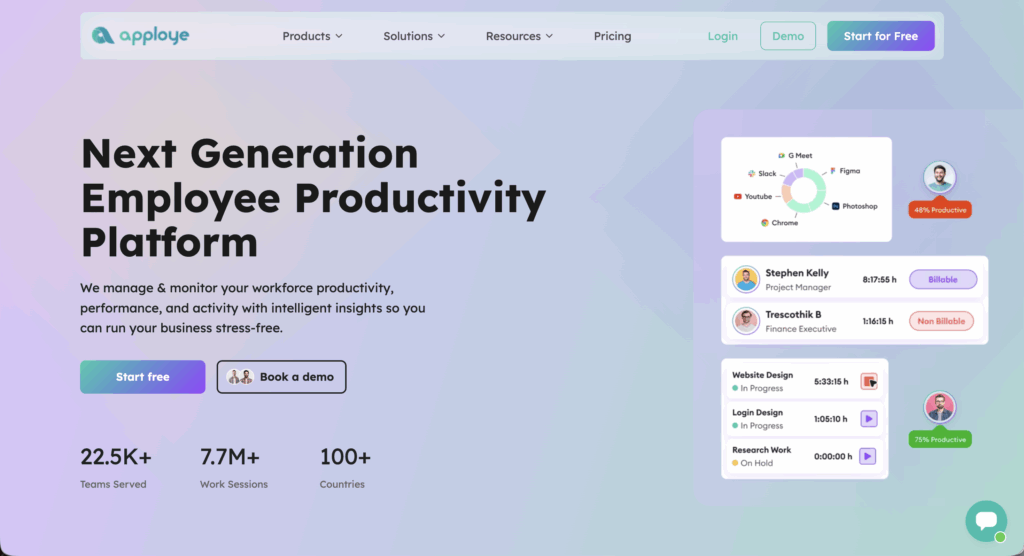
Apploye is a time tracking tool that helps businesses manage remote teams by logging work hours, monitoring screen activity, and organizing projects.
Why I chose Apploye: I liked that Apploye is geared toward remote teams that need to track hours time, just like virtual assistants.
Time tracking and screen monitoring
I liked Apploye’s time tracking offering. There’s a one-click timer that you can use on desktop and mobile, which makes it simple to start and stop work. There’s also offline tracking, which keeps logging hours even if you don’t have internet access, and just syncs the time once you’re back online.
Hours are recorded as timesheets, and you can view them by day, week, month, or custom range. Managers can approve or deny entries, but they can’t edit them, which I found a bit strange. Apploye also breaks time down by task or project, so you know which hours were spent on what.
On paid plans, you can access monitoring features like screenshots, URL and app tracking, and even a live feed of current activity. While this seemed a bit intrusive to me, I can see the value in it, if you want precise oversight into how your virtual assistant is spending their time. Apploye can also track idle time, separating it from active work so billing stays accurate.
Task management and interface
You can create projects with deadlines and descriptions, and then assign them to certain people. There’s also task management, but it’s very basic. Apploye lets you create, assign, and update the status of tasks under specific projects, but there’s no way to add comments, files, or dependencies. For the most part, it seemed like project and task management exists as another way to track time, rather than support productivity.
More than that, there’s no way to access projects, tasks, timesheets, or admin tools in the desktop and mobile apps. Even managers can’t assign tasks to themselves without having to switch to the web version. The desktop and mobile apps are limited to basic time tracking, without any other real functionality.
In contrast, you can’t track time on the web version, which I thought was strange. You would essentially need to have two versions of Apploye open in order to manage tasks and track time. This made the tool feel very restrictive to me, especially for teams that rely on mobile-first workflows.
Scheduling limitations
Apploye claims that they offer scheduling on their website, which even shows a screenshot of a calendar view. The website specifically mentions shift and employee scheduling, but I could not find any scheduling features when I looked on the web version, mobile app, and desktop app. I couldn’t even find documentation about scheduling in Apploye’s help center.
This is a bit disappointing, especially since it’s one of the key features virtual assistants often rely on. I also found it strange that Apploye would promote scheduling, when the product does not yet exist.
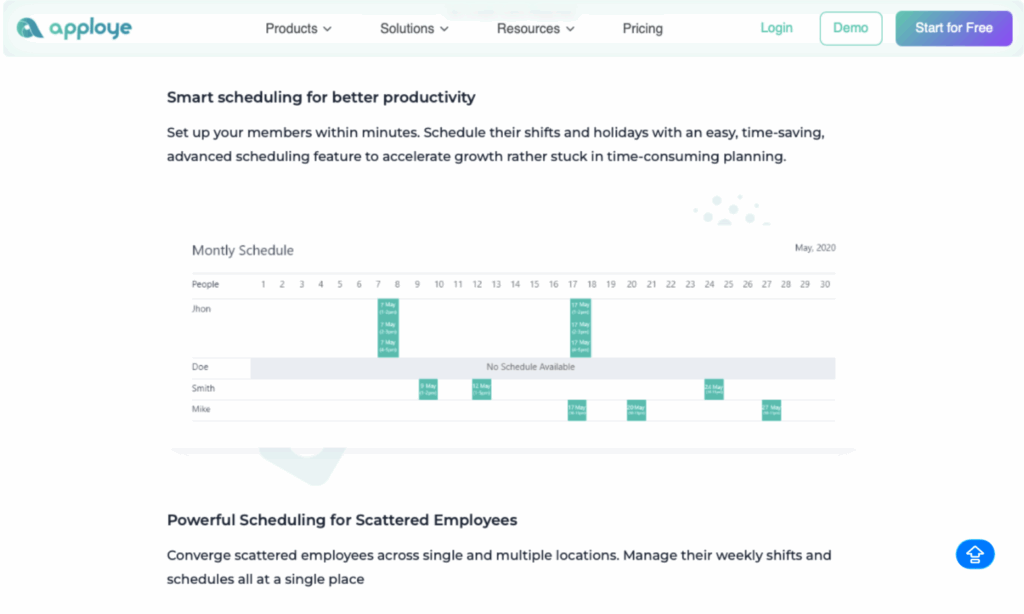
Screenshot of Apploye’s website taken on September 15, 2025. What users say about Apploye
What I like most about Apploye is how easy it is to track time and monitor employee activity. The screenshots, app/website usage tracking, and detailed timesheets give me full visibility, which makes managing productivity and payroll so much smoother.
The app doesn’t provide reporting functionality to be able to export employee’s timesheets in a way that allows you to identify tasks they are working on, which is essential if you need to use this beyond very basic applications. It also lacks important reminder notifications to turn tracking on/off so lots of time is often left untracked.
Key Features
- Time clock
- Screen monitoring
- Timesheets
- Projects and tasks
Pros
- Offline time tracking
- Reporting and analytics
Cons
- No scheduling features
- Limited integrations
Pricing
Starts at $4.50/user/month Trial: Yes — 10-day Free Plan: No
-

Calendly — Good for scheduling and appointment management
Available on
- Web
- iOS
- Android
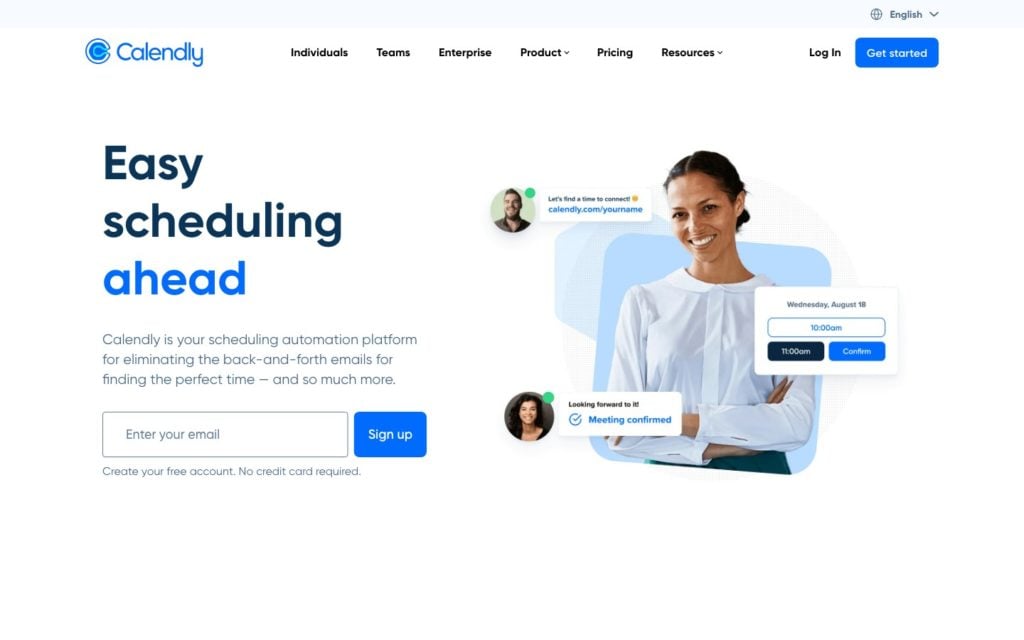
Calendly is a scheduling platform that helps automate booking for meetings and appointments.
Why I chose Calendly: I liked Calendly because it offers automated scheduling, which is important for virtual assistants handling multiple calendars.
Scheduling and calendar management
I liked how Calendly approaches scheduling. The tool connects to different calendars, including Google, Outlook, and Office 365, and uses the availability data to prevent double-booking across systems.
I also appreciated how many different types of events you can create: one-on-one meetings, events with multiple hosts, round-robin scheduling that rotates meetings between team members, and group sessions where a few people can book the same time slot. You can customize each event with durations, buffer time between meetings, and availability windows. All you have to do is share your link.
From there, invitees can see your availability and pick a time that works. Calendly also sends automated reminders by email or SMS, and you can even schedule follow-up emails post-meeting to continue the conversation or ask for feedback.
Integrations and workflow automations
What you can do with Calendly really transforms when you tap into its 100+ integrations. Integrating with CRMs like Salesforce and Hubspot lets you automatically capture leads, and you can collect fees at the time of booking with tools like Stripe and PayPal. For collaboration, you can generate links with video platforms like Zoom and Google Meet.
For virtual assistants, I especially liked the routing forms feature, which qualifies leads with an intake form and sends them to the right person based on their answers. When someone books a meeting, it can trigger so many different actions, including creating a follow-up task in your project management system. While it’s nice that there are so many integrations, I found the amount of capabilities almost overwhelming.
Platform limitations
Calendly really focuses on scheduling, which I thought was both a strength and weakness. There’s no task management, no built-in messaging, no file storage, and no time tracking. While integrations can definitely make up for some of these gaps, you end up with a patchworked set of platforms, logins, and fees.
I also thought the pricing was on the expensive side, starting at $10 per user per month. Since Calendly isn’t an all-in-one tool, the price doesn’t cover the additional software you would need for a full virtual assistant setup. While Calendly offers powerful scheduling, I don’t think it’s an app for virtual assistants to use on its own.
What users say about Calendly
I love that I can have multiple calendars with different purposes, colors, and time lengths to distinguish the kinds of meetings I’m having. I also like that I can set the amount of appointments and have automated reminders.
I think Calendly could have more flexibility with syncing with third-party tools like CRMs, online meeting software etc. Also, although the workflows Calendly has are a great idea, I do find them a little troublesome to use and put together.
Key Features
- Scheduling and booking
- Automated reminders
- Custom availability
- Multiple event types
Pros
- Strong integrations
- Clean user interface
Cons
- Niche-specific focus
- Requires integrations for full functionality
Pricing
Starts at $10/user/month Trial: Yes — Yes, 14-day Free Plan: Yes
Compare the Best Virtual Assistant Appss
| Topic |
 Start for free
Start for free
|
|
|

|

|
|---|---|---|---|---|---|
| Reviews |
4.8
|
4.5
|
4.7
|
N/A
|
3.8
|
| Pricing |
Starts at just $29/month for the first 30 users
|
Starts at $10.99/user/month
|
Starts at $8.25/user/month
|
Starts at $4.50/user/month
|
Starts at $10/user/month
|
| Free Trial |
yes
14-day
|
no
|
yes
|
yes
10-day
|
yes
Yes, 14-day
|
| Free Plan |
yes
Free Up to 10 users
|
yes
Up to 15 people
|
yes
|
no
|
yes
|
| Use cases |
Best all-in-one app for virtual assistants
|
Good for task and project management
|
Good for real-time communication and team collaboration
|
Good for time and activity tracking
|
Good for scheduling and appointment management
|
| Available on |
Web, iOS, Android
|
What Are Apps For Virtual Assistants?
Virtual assistant apps are tools designed to help business owners, managers, and individuals work more efficiently with remote assistants. Since virtual assistants are typically in different locations than their clients, it’s important to keep track of all remote work. Virtual assistant apps provide a structure for collaboration with features like task management, scheduling, communication, file sharing, and time tracking. Instead of managing scattered emails, documents, and platforms, apps for virtual assistants serve as a central place for all work and progress.
How Do Virtual Assistant Apps Work?
Apps for virtual assistants work by creating a shared digital workspace that clients and assistants can use to collaborate in real-time. Managers can use the app to assign tasks, track progress, and manage schedules, which makes it easier to stay aligned with virtual assistants.
Most apps have calendars, reminders, and file storage so everything is always accessible. Notifications alert users when task statuses change, deadlines near, or new messages come in. Some apps support automation, so you don’t have to manually follow up on tasks or create timesheets every pay period.
Virtual assistant apps aim to create a more organized workflow. By reducing the back and forth emails, messages, and phone calls, clients and assistants can both clearly understand where work stands.
What are the Benefits of Virtual Assistant Apps?
Here are some of the ways virtual assistant apps can help you and your business:
Improved efficiency
Virtual assistant apps streamline work by combining tasks, priorities, and progress tracking in one place. This replaces scattered emails, spreadsheets, and sticky notes, ensuring that everything is organized for quick access and ensuring that key projects don’t get overlooked.
Better time management
Built-in scheduling, reminders, and deadlines keep clients and assistants on track so they can manage their time more effectively. With a clear overview of needs to be done and when, you can reduce missed deadlines and help balance workloads more accurately.
Clearer communication
Since most virtual assistant apps offer messaging, file sharing, and real-time updates, it’s easier to collaborate across teams. With one central place for work-related communication, you cut down on email chains and keep everyone on the same page.
Centralized information
These apps serve as a central hub for tasks, files, and conversations. By centralizing all the relevant information, you avoid context switching, keep data organized, and find what you need faster.
Cost savings
Virtual assistant apps can help cut costs by reducing wasted time and the need for multiple tools. Since many apps combine key features, like scheduling, task management, and communication, you can considerably lower your software expenses and increase the return on investment for your business.
How Much Do Apps For Virtual Assistants Cost?
Apps for virtual assistants typically use subscription-based models, charging per user per month. Prices can range anywhere from $4 to $10 per user per month, with advanced platforms climbing to $15 to $25 per user per month, depending on the included features. These costs can add up quickly, even for small teams.
That’s where Connecteam stands out as the most affordable choice. Connecteam’s Small Business Plan is completely free for up to 10 users, and paid plans start at $29/month for up to 30 users. Higher tiered plans go up to $49/month for Advanced, and $99/month for Expert, both also including up to 30 users.
FAQs
You can ensure data security by choosing apps that offer encryption, role-based access, and compliance with regulations like GDPR or HIPAA. Connecteam provides secure data storage and audit trails, keeping sensitive information protected and your business compliant.
Integration challenges include incompatible data formats, limited API support, and workflow disruption. You can minimize these issues with careful planning, phased rollouts, and selecting apps with strong integration features.
The Bottom Line On Virtual Assistant Apps
Managing virtual assistants comes with unique challenges, especially since they work remotely. You need to track billable hours, keep tasks organized, and consistently stay aligned. Without the right app, things can get lost or delayed.
Apps for virtual assistants bring work together, simplify collaboration, and keep productivity on track. From logging time to sharing files, the right platform keeps both you and your virtual assistant aligned.
Connecteam stands out as the best choice. With an all-in-one platform that excels in task management, scheduling, communication, and more, it’s clear why so many businesses choose it as their virtual assistant app. Plus, with a Small Business Plan completely free for up to 10 users, Connecteam delivers value for companies of all sizes.




